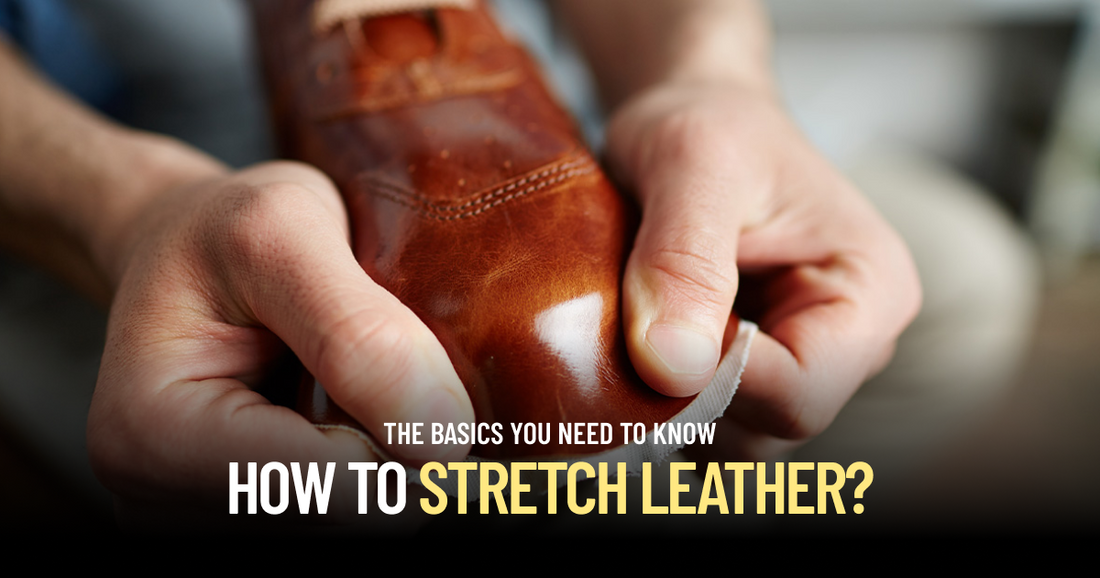Leather is timeless. Whether it's a pair of sleek shoes, a classic jacket, or a luxurious bag, we all love the look and feel of leather. But there’s one thing that stands between you and that perfect fit – the initial stiffness and tightness of brand-new leather. You might feel tempted to tough it out, but why wait weeks for your leather to mold when you can fast-track the process? With the right techniques, you can stretch leather quickly and comfortably, saving yourself the discomfort. Dive into this ultimate guide and discover how to break in your favorite leather pieces like a pro!
Why Stretching Leather is Necessary
Leather’s natural properties allow it to stretch and conform to its user’s body over time. However, this process can take weeks or months depending on how often you wear or use the item. Stretching leather is especially necessary when:
- Leather shoes feel tight and uncomfortable on your feet.
- Leather jackets feel too snug, restricting movement.
- Bags and accessories, like belts or straps, feel too short or stiff.
You can improve leather's longevity and comfort by stretching it. However, keep in mind that leather can only stretch to a certain extent. Overstretching can damage the seams or cause permanent distortion, so it’s important to follow the correct techniques.
Methods for Stretching Leather
There are several tried-and-true methods for stretching leather items, ranging from household solutions to professional products. Depending on the leather item you’re working with, you may want to try different techniques.
1. Heat Method
One of the easiest ways to stretch leather is by using heat. When leather is heated, it becomes more pliable, allowing you to stretch it without much effort.
Here’s how to safely use the heat method:
- Step 1: Use a hairdryer on medium heat and direct the airflow over the area you wish to stretch.
- Step 2: Move the hairdryer in circular motions to warm the leather evenly, keeping the dryer at least six inches away to avoid overheating.
- Step 3: Once the leather becomes warm and soft, wear the item (for jackets or shoes) or gently pull and stretch the leather by hand.
- Step 4: Continue moving and bending the leather until it cools down, which will help maintain the stretch.
Remember, when using heat, always avoid exposing leather to direct flames or excessive heat, as this can cause permanent damage.
2. Wear and Flex Method
For items like leather shoes or jackets, the wear-and-flex method is a natural way to stretch leather without using any additional tools or products. This method takes time but works best if you want to slowly and evenly stretch your leather goods.
- Step 1: Wear the item for short periods around the house.
- Step 2: For shoes, wear thick socks to create extra pressure inside, and for jackets, try layering clothing underneath.
- Step 3: Gently move to allow the leather to naturally twist, flex, and bend.
Over time, this will help break in the leather and mold it to your body, improving both comfort and fit.
3. Rubbing Alcohol and Water Solution
Using a rubbing alcohol and water solution is another safe way to stretch leather, especially for shoes or jackets. This method softens the leather without damaging it, but it should be done carefully.
- Step 1: Mix one part rubbing alcohol with three parts water in a spray bottle.
- Step 2: Lightly mist the leather areas you want to stretch, ensuring they are damp but not soaked.
- Step 3: Wear the leather item (such as shoes or jackets) or gently stretch the item by hand while it’s damp.
- Step 4: Allow the leather to dry while stretched, which will lock in the new shape.
This method is particularly useful for leather shoes that are just slightly too tight.
4. Ice Method
If you’re dealing with leather shoes or boots that are too tight, the ice method might be just the solution you need. Water expands as it freezes, and this expansion can help stretch tight leather shoes.
- Step 1: Fill two sealable plastic bags with water and place them inside the shoes.
- Step 2: Ensure the bags are securely sealed to prevent any leaks.
- Step 3: Place the shoes inside your freezer and leave them overnight.
- Step 4: As the water freezes, it expands, gradually stretching the leather.
- Step 5: In the morning, remove the shoes from the freezer and let them thaw for a few minutes before removing the bags.
This method works well for shoes, but use caution to ensure the leather doesn’t get wet, as moisture can damage some types of leather.
5. Leather Stretching Tools
For a more controlled stretch, leather stretching tools, such as shoe stretchers or leather expanders, are widely available. These tools are designed specifically for stretching leather shoes or boots, making them a great option for precision work.
- Step 1: Insert the shoe stretcher into the shoe or boot.
- Step 2: Adjust the tool to expand the shoe slowly.
- Step 3: Leave the stretcher inside for a few hours or overnight, depending on how much stretch you need.
If you purchase leather shoes or boots on a regular basis, these tools are a wise investment.
Step-by-Step Leather Stretching Process
No matter which method you choose, stretching leather requires patience and a careful approach. Here is a general process to follow for stretching leather:
- Identify the areas to stretch: Whether it’s shoes, jackets, or accessories, focus on the areas that need a bit of extra give.
- Choose the right method: Select one of the methods based on the leather item and the extent of stretching required.
- Test first: Always test on a small, inconspicuous area before applying any product or method to the entire leather item.
- Stretch gradually: Stretch the leather slowly and gradually, avoiding aggressive pulling, which can damage the material.
- Maintain the stretch: Once the leather is stretched, continue wearing or using it to maintain the fit.
Common Mistakes to Avoid
- Overstretching: Leather is flexible, but overstretching can cause permanent damage. Avoid stretching beyond 1/4 to 1/2 size for shoes or any similar limits for other items.
- Using improper tools: Using makeshift tools like pliers or overly heavy weights can tear the leather or damage its structure.
- Neglecting conditioning: Stretching leather can cause it to dry out. Always use a leather conditioner afterward to keep the leather soft and long-lasting.
Best Leather Stretching Products
If you’re hesitant about using household methods, several professional leather stretching products can help you achieve the desired results.
- Leather Stretching Spray: Leather stretching sprays are specially formulated to loosen leather fibers, making the material more flexible. Leather Farm offers premium leather stretching sprays that can be applied directly to shoes, jackets, and bags.
- Leather Conditioners: Applying a leather conditioner after stretching helps maintain the quality and elasticity of the leather. Conditioners not only stretch but also moisturize, ensuring your leather items remain supple for years.
Conclusion
Stretching leather doesn’t have to be a daunting task—it’s all about patience, care, and using the right techniques. Whether you're giving a snug pair of shoes a little more breathing room or ensuring your jacket fits like a glove, the results are worth it. Remember, leather is a material that’s built to last and respond to your movements. By following the methods outlined in this guide, you’ll enjoy not only a better fit but also the longevity and luxury that leather offers. So why wait? Start stretching and make those leather items truly yours.


